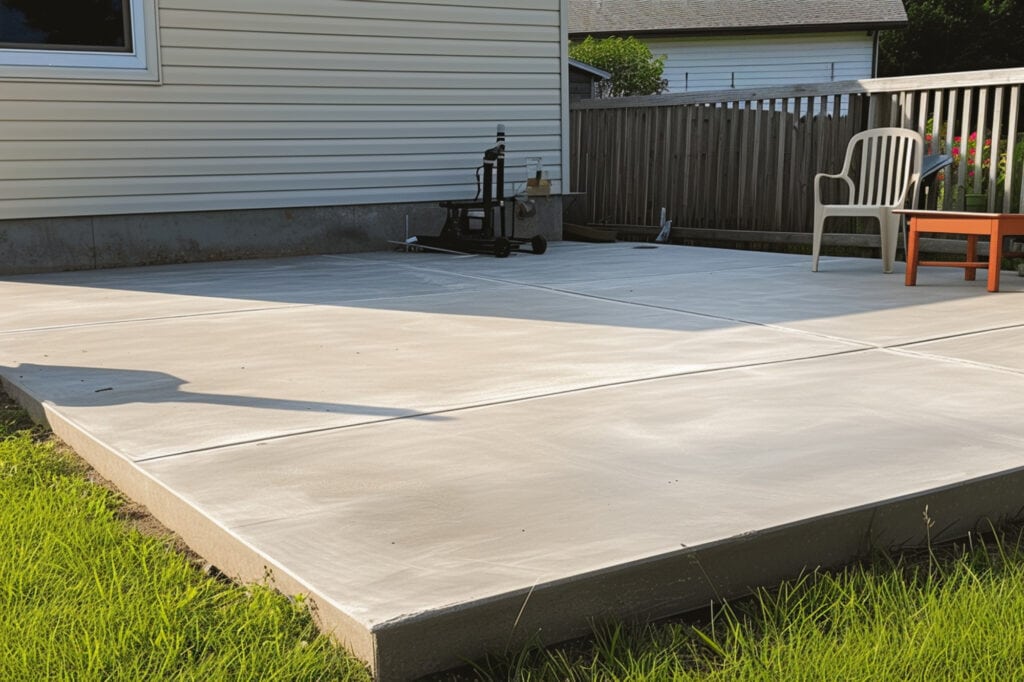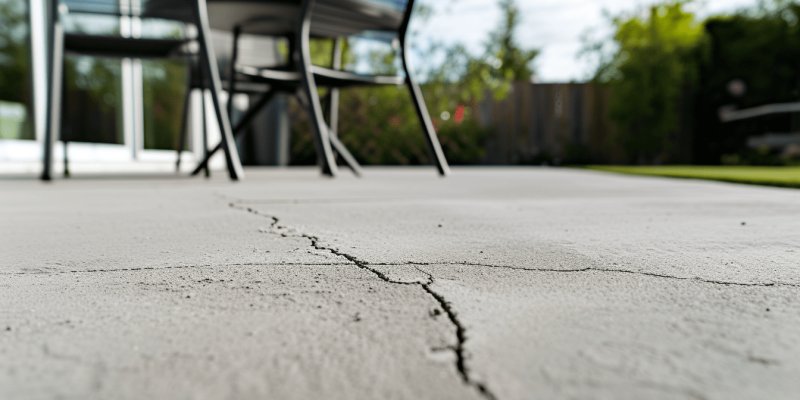Discover essential tips for repairing and maintaining your concrete patio in Springfield’s variable climate. From identifying crack types to effective DIY repairs and preventive care, this guide helps you extend your patio’s life and keep it looking its best.
Understanding Concrete Patio Cracks
Cracks in your concrete patio can be more than just an eyesore; they’re clues to the health of your patio. Like a detective, understanding these cracks is the first step towards a beautiful and safe outdoor space. Let’s decode the types of cracks you might encounter in Springfield and their underlying causes.
Types of Cracks
- Narrow Cracks: Often the first sign of wear, these small, thin cracks can sneak up on your patio. They’re usually the result of minor settling or the seasonal dance of temperature changes in Illinois. While they might seem trivial, addressing them early can prevent more significant issues later on.
- Wide Cracks: When a crack graduates from narrow to wide, it’s time to pay attention. These larger cracks are more than just cosmetic flaws; they can hint at deeper issues with your patio. Wide cracks require a more robust approach to repair and are often the messengers of more serious underlying problems.
- Structural Cracks: These are the cracks that raise red flags. Structural cracks compromise the integrity of your concrete patio, affecting its stability and safety. They demand immediate attention and often professional intervention.
Causes of Cracks
- Environmental Factors: Springfield is known for its diverse weather, and unfortunately, our patios are often on the receiving end. The expansion and contraction caused by temperature fluctuations and moisture can lead to cracking. It’s a battle against nature that your patio sometimes loses.
- Age and Wear: Like many things, concrete patios age and show signs of wear over time. Regular use, the harsh Illinois winters, and the passage of time can all contribute to the formation of cracks.
Tools and Materials Needed
Having the right tools and materials at hand is crucial for a successful repair. Here’s a detailed list of what you’ll need to tackle those pesky patio cracks.
- Wire Brush and Broom: Start your repair with a clean slate. A wire brush will help you scrub out the small particles lodged within the cracks, while a broom sweeps away the loosened debris. This step is essential for ensuring the filling material adheres properly.
- Concrete Crack Filler: This is your go-to solution for narrow cracks. Available in easy-to-use cartridges, these fillers are designed to seep into small crevices and solidify, forming a strong bond that prevents further cracking. Look for a filler suitable for outdoor use to withstand Springfield’s weather.
- Vinyl Concrete Patching Compound: When dealing with wider cracks, a vinyl concrete patching compound is your best friend. It’s a more robust material that can fill larger gaps and, once cured, forms a durable, weather-resistant surface. Ensure you choose a compound that’s compatible with your patio’s concrete type.
- Caulking Gun: If you’re using a crack filler in a cartridge, a caulking gun will help you apply it with precision and ease. It allows you to evenly distribute the filler along the length of the crack, minimizing waste and mess.
- Chisel and Hammer: For wider cracks, you’ll need to chisel out any unstable concrete before applying the patching compound. This helps create a clean, receptive area for the new material to adhere to, ensuring a more lasting repair.
- Trowel: A must-have for applying and smoothing out the patching compound. A trowel will help you achieve a level surface that blends with the rest of your patio.
- Safety Gear: Safety should always be your priority. Durable gloves will protect your hands from sharp edges and harsh chemicals, while safety glasses are essential to shield your eyes from flying debris and dust.
NOTE
These tools are readily available at local hardware stores in Springfield. Having the right tools at hand makes the repair process smoother and more effective.
Repairing Narrow Cracks
Narrow cracks might seem minor, but they can lead to major issues if left unaddressed. Here’s a detailed guide to effectively repair these small fissures in your concrete patio.
- Cleaning the Area
- Why It’s Important: The first step in any repair is to ensure the area is clean. Dirt, debris, and loose concrete can prevent the filler from adhering properly and compromise the repair.
- How to Clean: Use a wire brush to aggressively scrub inside the crack. This removes small particles and loosens any weak concrete. Follow up with a broom or a leaf blower to clear out the debris. For best results, consider using a garden hose or pressure washer for a thorough clean, but ensure the area is dry before applying the filler.
- Applying Crack Filler
- Choosing the Right Filler: For narrow cracks, a masonry concrete crack filler is ideal. Look for a high-quality filler that can withstand temperature changes and moisture – common issues in Springfield.
- Application Process: Cut the tip of the filler cartridge, and insert it into a caulking gun. Carefully apply the filler along the crack, making sure it gets deep into the crack for optimal adhesion. For deeper cracks, you may need to apply the filler in layers, allowing each layer to dry before applying the next.
- Finishing Touches
- Smoothing the Surface: Once the crack is filled, use a trowel or putty knife to smooth the filler. This not only ensures a level surface but also helps in blending the repair with the surrounding area.
- Curing Time: Let the filler cure as per the manufacturer’s instructions. Curing time can vary, but it’s crucial for the durability of the repair.
- Post-Repair Care: Avoid walking or placing heavy objects on the repaired area until it’s fully cured. If you plan to paint or seal your patio, wait until the filler has completely set.
Remember, while narrow cracks may seem minor, addressing them promptly can prevent them from widening or causing more serious issues. This DIY fix is perfect for Springfield homeowners looking to maintain their patios without professional intervention.
Addressing Wide Cracks
Wide cracks in your concrete patio can be daunting but are entirely manageable with a methodical approach. Here’s how to tackle these larger fissures effectively.
- Preparing the Crack
- Widening the Crack: Use a chisel and hammer to gently widen the crack. This step may feel like you’re making the problem worse, but it’s essential for a thorough repair. By widening the crack, you create a more receptive space for the patching compound.
- Cleaning Out Debris: After widening, thoroughly clean out the crack. Remove all loose concrete, dirt, and debris. A wire brush can be helpful here. The cleaner the crack, the better the patching compound will adhere.
- Using Concrete Patch Compound
- Selecting the Right Compound: Choose a high-quality vinyl concrete patching compound, which is specifically designed for filling wider cracks. These compounds have greater flexibility and bonding strength, ideal for the temperature fluctuations in Springfield.
- Mixing the Compound: Follow the manufacturer’s instructions to mix the compound. Achieving the right consistency is crucial for the application process – it should be malleable but not too runny.
- Filling the Crack: Use a trowel to apply the compound into the crack. Press the mixture firmly into the crack, filling it completely. Take your time to ensure no air pockets are left within the crack.
- Leveling the Surface: Once filled, use the flat side of the trowel to smooth and level the compound with the patio surface. Aim for a uniform finish that blends seamlessly with the surrounding area.
- Curing and Sealing
- Curing Process: Allow the patching compound to cure as per the instructions. This can vary from a few hours to a day or more, depending on the product and weather conditions.
- Importance of Sealing: After the repair cures, consider sealing your entire patio. This provides an additional layer of protection against moisture, UV rays, and further cracking. Use a sealant that’s compatible with your concrete type and local climate conditions.
Addressing wide cracks is crucial for maintaining the structural integrity of your patio. While it requires a bit more effort than narrow cracks, the process is still doable for a dedicated DIYer in Springfield. If the crack seems too large or deep, it might be time to consult a professional.
Dealing with Structural Cracks
Structural cracks in your concrete patio can be a red flag for more serious issues, requiring a specialized approach for effective management. Here’s a detailed look at how to handle these significant cracks.
- Identifying Structural Cracks
- Characteristics: Structural cracks are typically wider than a quarter-inch and may run deep into the patio, often extending across its surface. They are distinct from the smaller, hairline cracks that are more common and less concerning.
- Underlying Issues: Such cracks may signal deeper problems with the patio’s foundation, such as settling or shifting soil beneath it. In Springfield, soil composition and weather patterns can contribute to these foundation issues.
- Why Professional Help is Essential
- Safety Concerns: Structural cracks can pose a risk to the safety and structural integrity of your patio. They may indicate a compromised foundation that requires expert evaluation.
- Expert Assessment: A professional concrete contractor can assess the severity of the crack and determine the underlying cause. They have the expertise to evaluate whether the issue is merely superficial or indicative of a more serious structural problem.
- Local Expertise: In Springfield, it’s beneficial to consult contractors familiar with local soil conditions and environmental factors. They can provide tailored solutions that consider these local nuances.
- Temporary Measures
- Immediate Action: While you arrange for professional assessment, there are temporary measures you can take to prevent the crack from worsening. Start by thoroughly cleaning the crack to remove debris.
- Applying Sealant: Use a flexible sealant to fill the crack as a temporary fix. This can help prevent water infiltration and further erosion in the short term.
- Limitations: It’s important to remember that these measures are not long-term solutions. They serve as a stopgap until a professional can perform the necessary repairs.
Structural cracks are a sign that your patio may need more than just a simple fix. Addressing these promptly ensures the longevity and safety of your outdoor space.
Hiring a Concrete Contractor for Severe Cracks
For significant or structural cracks in your patio, hiring a professional concrete contractor is often the best solution:
- When to Call a Professional
- Recognizing Serious Issues: If your patio has wide, deep, or multiple cracks, or if there are signs of sinking, unevenness, or large gaps, these are clear indicators that professional help is needed. Such issues often go beyond surface-level problems and could signify deeper structural concerns.
- Risk Assessment: Remember, DIY solutions might be feasible for minor cracks, but for major issues, incorrect repairs can lead to more significant problems down the road, including safety hazards.
- What to Expect from a Contractor
- Initial Inspection: A skilled contractor in Springfield will start with a thorough inspection of your patio. This involves assessing the extent of the damage and identifying potential causes, such as soil issues, poor drainage, or substandard initial construction.
- Repair Techniques: Depending on the problem, various repair methods may be proposed. Techniques like slab jacking (raising and leveling sunken concrete by pumping a material underneath) or installing piers (to support and lift sinking concrete) are common solutions for structural issues.
- Expert Advice: A good contractor will not only fix the problem but also advise on preventing future issues, considering Springfield’s specific climate and soil conditions.
- Cost Considerations
- Investment in Safety and Quality: While professional repairs can be more costly than DIY fixes, they are a critical investment in the safety and longevity of your patio.
- Price Factors: The cost will vary depending on the severity of the damage, the required repair methods, and the contractor’s rates. Complex repairs like slab jacking or underpinning will cost more due to the materials and expertise needed.
- Getting Quotes: It’s advisable to get estimates from several contractors to compare prices and services. Don’t just go for the cheapest option; consider the contractor’s reputation, experience, and proposed solutions.
Remember, the safety and longevity of your patio are paramount. In cases of severe cracks, professional expertise is essential to ensure a lasting repair.
Preventive Measures and Maintenance

Proper care and maintenance of your concrete patio can significantly extend its lifespan and maintain its aesthetic appeal. Let’s break down the essential preventive measures and maintenance routines into detailed steps.
Regular Inspection
- Importance of Frequent Checks: Regularly inspect your patio for any signs of wear, damage, or small cracks. This is particularly important after extreme weather conditions, which Springfield often experiences.
- Early Detection: Catching minor issues early can prevent them from escalating into larger, more expensive problems. Look for changes in the concrete’s color, texture, or surface integrity.
- Post-Weather Checks: Following heavy rain, snow, or extreme temperature fluctuations, give your patio a thorough inspection to catch any new or worsening damage.
Sealing and Weatherproofing
- Benefits of Sealing: Applying a high-quality concrete sealant every few years is crucial in protecting your patio. Sealants act as a barrier against water penetration, freeze-thaw cycles, and damaging UV rays.
- Choosing the Right Sealant: Select a sealant appropriate for the Springfield climate. Consider products that offer UV protection and water resistance.
- Application Tips: Clean the patio thoroughly before applying the sealant. Follow the manufacturer’s instructions for the best results, and allow the sealant to dry completely before using the patio.
Avoiding Heavy Loads
- Weight Management: Excessive weight from heavy furniture, equipment, or large gatherings can stress the concrete, leading to cracks.
- Strategic Placement: Distribute weight evenly when placing heavy objects on the patio. Use furniture pads or rugs to minimize direct contact and pressure points.
Proper Drainage
- Preventing Water Accumulation: Ensure that your patio has adequate drainage to avoid water pooling. Standing water can weaken concrete over time, leading to cracks and other damage.
- Drainage Solutions: If drainage is an issue, consider installing drains or adjusting the landscaping around your patio to facilitate better water flow away from the concrete surface.
Regular maintenance and preventive measures are key to preserving the beauty and functionality of your concrete patio in Springfield. By staying vigilant and proactive, you can enjoy your outdoor space for years to come.
Conclusion
Fixing cracks in your concrete patio not only enhances your home’s curb appeal but also prevents further damage and costly repairs. Whether you tackle narrow cracks yourself or call a professional for larger issues, proper care and maintenance are key. Remember, a well-maintained patio in Springfield is an investment in your home’s value and your outdoor enjoyment.

